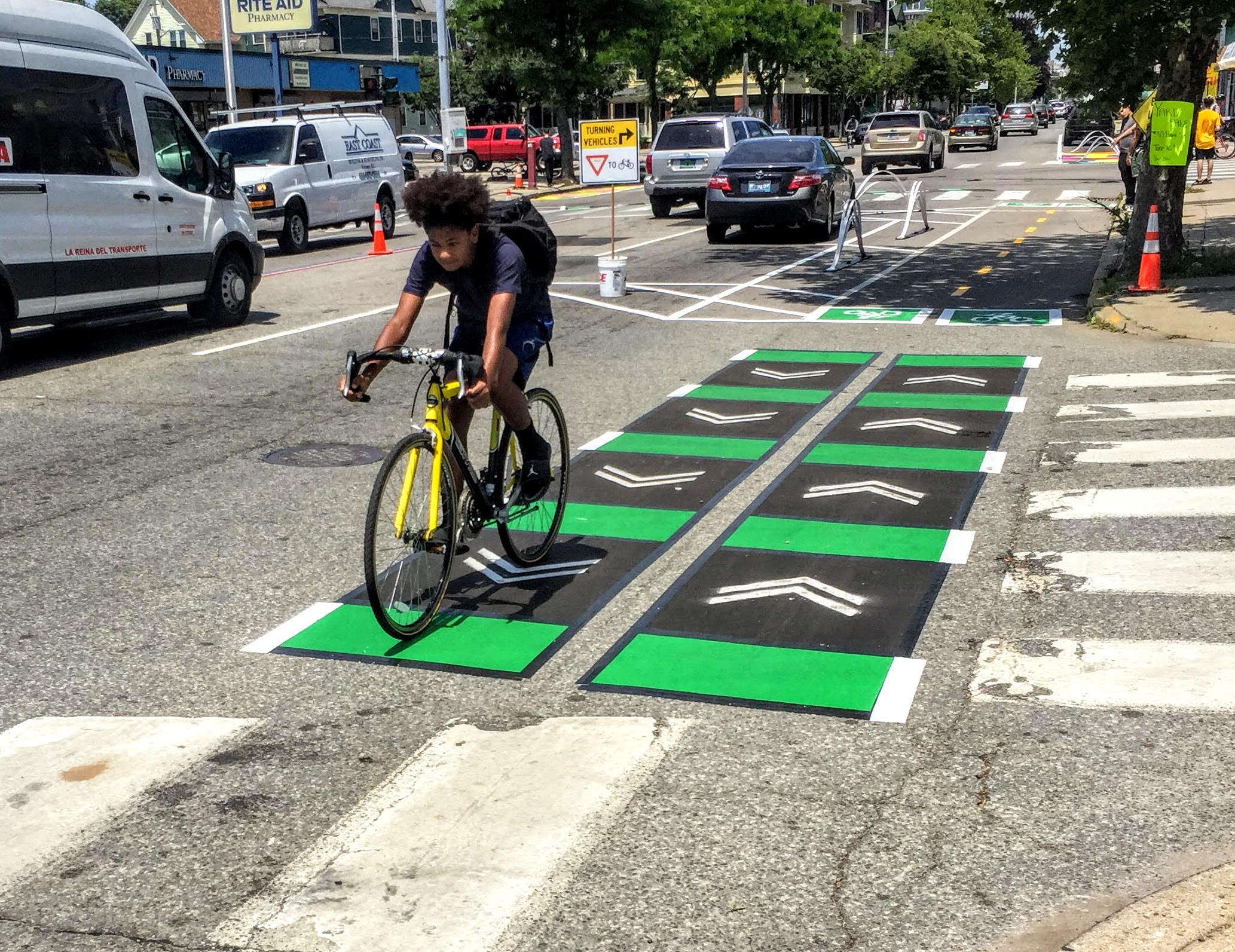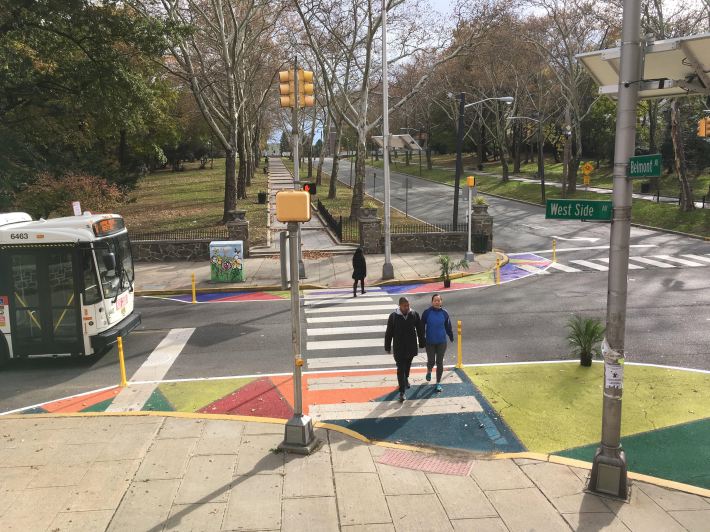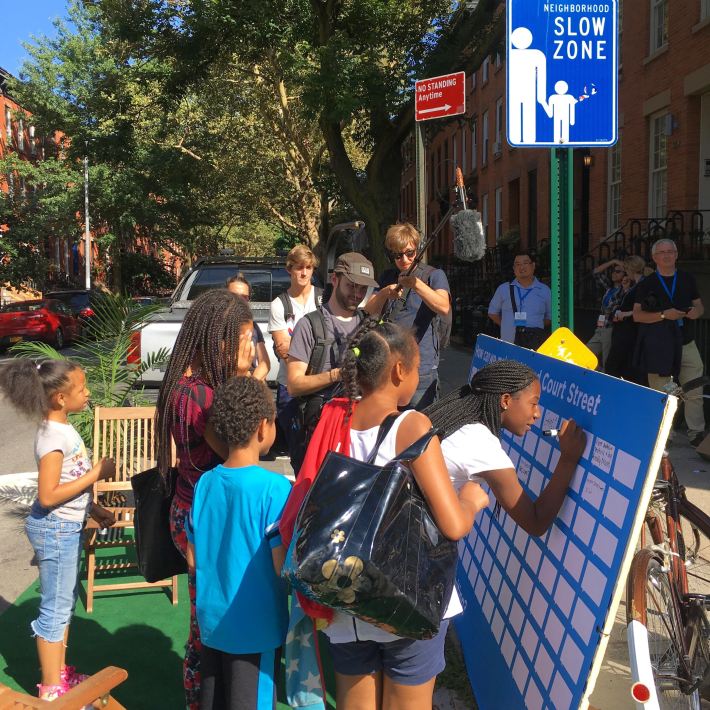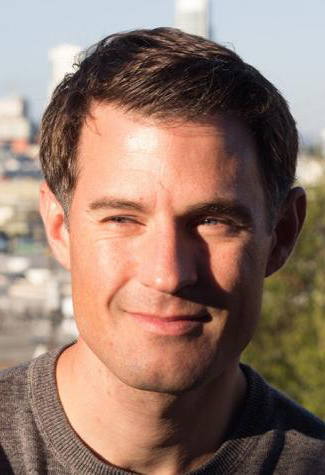Can Tactical Urbanism Be a Tool for Equity? A Conversation with Mike Lydon and Tony Garcia
10:39 AM EDT on July 6, 2020

Source: Street Plans
As the co-authors of Tactical Urbanism: Short-Term Action, Long-Term Change Vol. 1 – 5 and co-principals of the planning firm Street Plans, Tony Garcia and Mike Lydon are among the most influential voices in the conversation about the quick-build projects and quick-shift policy changes in the built environment. Their work has been the subject of much debate in the urbanism world lately, especially as cities across America again return to Slow Streets and other tactical urbanist strategies in the wake of a new rise in COVID-19 cases — but don't always center the demands of communities of color in these projects, both before and after the traffic control barriers go up. We talked with them to discuss how they’re processing the rapidly evolving conversation about the racial and social equity implications of their governing methodology, as well as how the field of tactical urbanism itself is changing in response.
"Open Streets" and "slow streets" programs have become much more visible in U.S. cities since the COVID-19 pandemic began — and so has conversation about the equity implications of these programs, especially in the wake of national protests against systemic white supremacy. Talk me through how you've been processing that conversation.
Mike Lydon: At first, it was definitely encouraging to see cities utilize the Tactical Urbanism methodology as a way to respond to all the mobility challenges that have emerged to the pandemic — at least, in terms of the physical side of those challenges. Cities have found utility in the idea that they can act and must act quickly, make a change [to their street environment,] and then apply the feedback that’s presented by community members so it can serve them better.
But some of the applications of the methodology did give me concern. At least a first, there was a lot of talk from cities along the lines of, "Hey, let’s put an Open Street along the waterfront." Or, "Hey, let’s do an Open Street within that big, signature park in our community." When you start to think about the people who that really serves, and who has access to those types of changes, you start to see the inequities; it’s completely obvious, and it became even more obvious as the data started to come out about who was disparately impacted by the pandemic. Then we started having some difficult conversations about whether Open Streets were what people needed most, especially in [predominantly non-white] communities like Jackson Heights here in New York.
Then when the Minneapolis police killed George Floyd, and the Louisville police killed Breonna Taylor, when the protests started, this moment just became a tinderbox of issues in the urbanism world. People started questioning whose voices urbanism has been promoting, including ours.
Tony and I have primarily been in listening mode since then. We know we've put forth a methodology that has, historically, been a really important tool for responding to inequity in communities across the globe. In some instances, yes, it can be an important healing and community affirming tool that leverages the best of the residents' knowledge of their own neighborhood; in other instances, it may not. We recognize that, in our own work, we have maybe not been as critical as we should be in working with our clients, and in how our projects get developed and implemented in communities, and in thinking through why we do those projects. That is something we could all do better at. We’re really taking a hard look.
Tony Garcia: I would echo a lot of what Mike said about us just being in listening mode. We’ve always thought of tactical urbanism, and the entire idea of quick-build methodology, as something that's designed to address how shitty government is at delivering on problems in a way that responds to what lots of people actually need. And I think that the conversations we’re having right now — specifically, with people of color who are saying, "This [tactical urbanism project] is not what we need right now" — I hear that as something similar: that governments, and consultants like us whom governments hire, just don't listen. That [government] is not giving communities what they need.
[Tactical urbanism] is supposed to be a process that seeks to upend a public planning process that comes from the 1950s and earlier — one that’s not flexible or transparent, that’s not meant to actually engage anybody at all, even if it requires a ton of “community engagement” sessions. And we think that tactical urbanism is a methodology that actually addresses problems that disproportionately impact communities of color. Our whole methodology is: listen first, and then design around what people need, instead of the other way around. But we can fail to follow through on that methodology, and we need to be attentive to that.

Give me an example of how you've tried to revisit your commitment to anti-racism in your application of the tactical urbanism methodology.
TG: Even as recently as last month, we’ve been going back to our clients and challenging them. And on new projects, we're saying, "Look: is this really what we should be doing?" When we’re hired for projects, we’re asking ourselves, "Are we being hired for a specific outcome, or are we hired for the process that gets us to an outcome that’s authentically arrived at through conversations with people where they live?"
There are times where we come in and say, "OK, we’re going to do a bike lane, because we were hired to do a bike lane." And then there are other times when we’re really reflective, and we say, "This bike lane is not what this community needs, it’s not what they’ve told us they want, and therefore we’re not going to do a bike lane." We’re under a lot of pressure, as consultants, to do what our clients want, but also, our clients should know, when they come to us, that what they’re getting is a consultant who’s willing to push back.
I want to talk about how much, specifically, you even can challenge a client who just wants you to build another bike lane — especially when you've been hired by a department of transportation, but the residents you're engaging with say their biggest problem isn't a transportation problem at all, and maybe the department that could solve their problem simply can't or won't work with you. The movement to defund the police has challenged practitioners to question rigid boundaries between city departments and city department budgets; is that a challenging barrier to break, in your experience?
ML: When we take on any client, we try to think through how responsive they can be, and how forward thinking they can be. And yes, we’ve had experiences in the past where, we’ve gotta put dinner on the table, too, so we take on a client who's made us say, "Eh, I don’t know if this is a great fit..." As people who started this firm relatively young, in our late 20s, we’ve learned a lot in a decade about what makes for a good client and a good situation for us, and we can afford to be be a little more selective now.
But even still, you can't change the allocation of public money overnight. But I think we can be supporters of doing it. And where we have openings to recommend more holistic changes, we do that, too.
A good example is our Jersey City bike master plan; we worked extremely closely on that project with [transportation researcher] Charles Brown to develop a very, very strong equity plan for that project. It touched on land use, and housing, and policing, and a whole bunch of things, and we did that specifically to take a wider, more systemic look at what the problems in that community were. Biking is important, and it’s great, and it can solve some problems, but it’s operating in a system that is inherently inequitable. There are many other related and connected concerns, and we can manage and respond to those, even when we have a limited scope of work.
TG: One thing we’ve been grappling with along these lines is a project here in Miami-Dade County, where I live. One of our commissioners here has been fighting for a rail connection that the Black community has been promised for at least 30 years. And I’ve been trying to start conversations with her, like, "Hey, why don’t you do a tactical transit lane along this corridor for three miles, just to get something in the ground now? You’ve been fighting for this piece of infrastructure for 30 years, and nothing’s happened, right? So why not do something that’s going to effect travel times and allow for better access to jobs and opportunity?"
And her staff’s answer to me has, consistently, been, “We’re not going to settle for anything less. That’s a compromise that we shouldn’t have to make. We’re talking about decades of deferred maintenance and investment, while the white neighborhoods get the highways that they demand right away, and we’re still here waiting.”
I understand that point of view, I do. But you’re still also not experiencing the benefit of this [tactical transit lane] when you can. I'm still wrestling with that.

Let's talk about community engagement. One of the most consistent criticisms of the TU methodology that I've noticed lately is that, by their nature, quick-build projects don't center the needs of the communities they're built in, because they don't typically make time for community engagement before the bike lanes go up — and that's a problem, even if the bike lanes are temporary. I've heard proponents say tactical urbanism is community engagement, because the methodology asks practitioners to edit their designs specifically in response to community feedback. How do you react to conversations like these?
ML: I think we’ve always prided ourselves on being really creative and on-the-ground with our community engagement. Yes, the project itself does act as a platform for engagement, but what a lot of people don’t see is that, oftentimes, there’s a lot of engagement that leads up to the project. At least in how we practice tactical urbanism — I can’t speak for everybody. We actually do a lot of door knocking and conversations and, of course, forums and workshops, focus groups, and trying to reach people in a variety of different ways. The best of our projects have had the ability to do that, and the best outcomes represent that process.
But when people say, “Just don’t come drop something into our community,” that's very valid. And I think they’re particularly valid at this moment with the pandemic, when communities are experiencing disparate impacts.
But I also think the answer isn’t, “Do nothing.” We should act, but we should absolutely be listening. In the middle of a sudden crisis event like a pandemic, a city can't wait to hold a 12-month planning process — they just can’t — because people still need to get to work safely under radically new conditions. But I think we can work quickly to communicate, and building relationships in these neighborhoods with people who live there, and keep going back to them to hear and respond to their concerns — while also dealing with the systemic problem of mobility at a city-wide scale.
How is your approach to tactical urbanism changing in response to this historic moment?
TG: We're trying to ask ourselves: in process of ideation, how can we work with people to create a level of authorship and co-production, so it’s not just us imposing this project on them? How can we make it so this project is, really, a conclusion that we came to together, and that the community feels they can own, because they were there from the inception? How can we start that co-creation process, especially in communities of color?
This interview has been edited for clarity and length.
Kea Wilson has more than a dozen years experience as a writer telling emotional, urgent and actionable stories that motivate average Americans to get involved in making their cities better places. She is also a novelist, cyclist, and affordable housing advocate. She previously worked at Strong Towns, and currently lives in St. Louis, MO. Kea can be reached at kea@streetsblog.org or on Twitter @streetsblogkea. Please reach out to her with tips and submissions.
Read More:
Stay in touch
Sign up for our free newsletter
More from Streetsblog USA
Should Wednesday’s Headlines 86 SUVs?
American tax law encourages people to buy the gas-guzzling and deadly vehicles, but some in Canada are pushing to ban them.
Tuesday’s Headlines Fix It First
How voters incentivize politicians to ignore infrastructure upkeep. Plus, are hydrogen trains the future of rail or a shiny distraction?
Why We Can’t End Violence on Transit With More Police
Are more cops the answer to violence against transit workers, or is it only driving societal tensions that make attacks more frequent?
Justice Dept., Citing Streetsblog Reporting, Threatens to Sue NYPD Over Cops’ Sidewalk Parking
The city is now facing a major civil rights suit from the Biden Administration if it doesn't eliminate illegal parking by cops and other city workers.
Five Car Culture Euphemisms We Need To Stop Using
How does everyday language hide the real impact of building a world that functionally requires everyone to drive?






